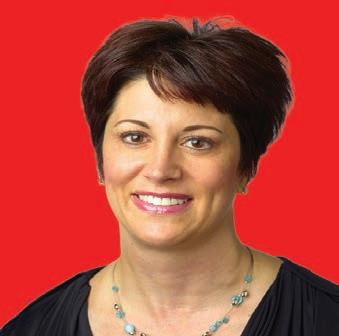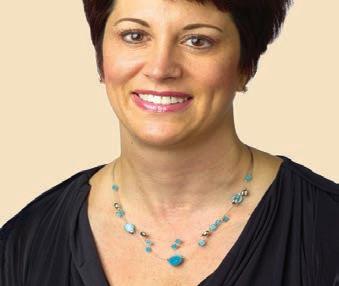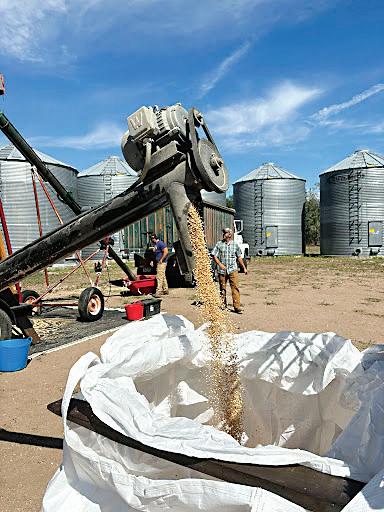






Less than a week after winning and accepting re-election this November, Denver state Sen. Chris Hansen announced he would vacate his seat.
His resignation announcement came just days after securing reelection, leaving a vacancy committee responsible for choosing his replacement, and hoisting any potential replacements into a game of political musical chairs. Hansen’s last day is Jan. 9. e timing of Hansen’s resignation has earned him some political sideeye from constituents, who are now unable to vote for his seat until 2028, as well as some of his fellow Democratic colleagues.
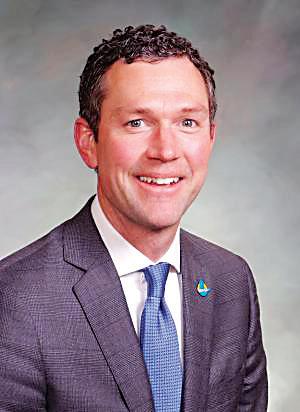
BY LONDON LYLE
SPECIAL TO COLORADO COMMUNITY MEDIA
A chant rang out through Riverside Church in Je erson Park during a December meeting as the Denver Classroom Teachers Association (DCTA) rallied to launch their bargaining campaign for the 2025 scal year.
“Who’s got the power? We’ve got the power! What kind of power? Union power!”
It’s been three years since the DCTA has last bargained with Denver Public Schools (DPS), and despite the evening’s snowy weather, supporters were more red up than ever before.
Educators, students, activists and community members donning bright red clothes to signal their support for the union lled nearly every seat in the auditorium of Riverside Church, demanding fair wages, more manageable workloads, smaller class sizes and equitable treatment for DPS employees.
DCTA President Rob Gould outlined the union’s priorities in simple terms.
“We’re here tonight because DCTA bargaining is starting in
2025, and we understand the importance of standing united for the schools our students deserve,” Gould said. “One job should be enough for our committed, dedicated educators who show up and give their all to support students every day.
“We shouldn’t have to walk out of the school building at the end of the strenuous day and hop into their car to drive for Uber, or put on an apron to work at the co ee shop,” he continued. “One job should be enough.”
e rally brought together educators from across the district who shared their personal struggles with underfunding, overwork and alleged discrimination.
“I’ve seen teachers being pushed out of this district, especially teachers of color,” said Brian Weaver, a sixth-grade math teacher and bargaining team member. “Equity for our students and retention for our educators are at the heart of this ght.”
Colorado Community Media has reached out to DPS for comment.
Valerie Henderson, an early childhood education teacher at Sandra Todd-Williams Acad-
emy and a bargaining team member, explained that the families and students that DPS serves experience systemic inequities due to socioeconomic, racial and political factors.
“ e Denver Green School absorbed 200 new-to-country students in just 18 months, while other schools maintained classes of just 22 students. is isn’t a coincidence. is is systemic racism in action,” she said.
Special education teacher Alicia Lerose described the burden of excessive workloads on those who work with students with complex IEP (Individualized Education Plans) or 504 learning plans; despite actually needing resources to spend more one-on-one time with her students who need specialized care. “I’m doing the job of at least three people. Crisis is at an all-time high,” she said.
Henderson pointed to the challenges of growing class sizes for educators working with students with disabilities.
“We’ve seen special education classrooms, which are supposed to be small by design, ballooning to sizes of 30 or more students,” she said.
Notably, the United Federation of Teachers recommends a sta ng ratio of no more than 12 or 15 students per teacher, depending on grade level, for special education classrooms.
Other educators echoed her concerns about large class sizes and limited resources.
“With 35 students per class, if I spend just 90 seconds with each student, that’s my entire class period,” said Michelle Horwitz, teacher and co-chair of the DCTA bargaining team.
“We cannot give our students what they need in this situation.”
Students themselves were in attendance, many of them there to support their fellow classmate and the rally’s only student speaker, Phoebe Davis, the senior class president at East High School. Davis highlighted the impact of teacher turnover on students like herself and her peers.
“When teachers leave, our students lose the mentors, trust, and champions who inspire them,” she said. “Call the board. Write Marrero. Show up at the rallies. Teachers cannot sustain this ght alone.”
While vacancy committees are put in place in case of situations like these, they are widely contended. Just four days after voters reelected him, Hansen signed a contract to become the CEO of La Plata Electric Association, a Durango-based utilities company. His predecessor reportedly earned $545,000 annually, which is roughly 13 times what Hansen makes as a legislator. Critics argue his move leaves constituents in the lurch, just as the legislative session is set to begin.
Colorado’s vacancy committee process is designed to ll legislative seats as soon as possible. e Colorado Democratic Party’s Senate District 31 vacancy committee, made up of 109 members, will meet on Jan. 7 to choose Hansen’s successor. Whoever is picked will serve the remainder of his term, which runs through 2028 .
e vacancy committee meeting will include a candidate forum where nominees will answer pre-submitted questions from the public. Only committee members can vote, and they must be present—proxies are not allowed.
Adding to all this is Hansen’s endorsement of state Representativeelect Sean Camacho of District 6 as his successor.
If Camacho is selected, then his newly won House seat will open up and require a quick replacement. is decision will also be left up to another vacancy committee.
Katie March, who lost to Camacho during the June primary, is Hansen’s top pick for the representative role.
BY ALLEN COWGILL SPECIAL TO COLORADO COMMUNITY MEDIA
e Denver Department of Transportation and Infrastructure (DOTI) is accelerating its rollout of the citywide compost collection program. All Denver neighborhoods will start getting compost pickup by March.
To accelerate the rollout, DOTI is making a trade o , eliminating the weekly pickup of recycling. Denver residents will instead get recycling pickup every other week. Compost pickup will be weekly as will trash pickup.
Another change to make the accelerated compost rollout possible is largeitem pickup will only come once every nine weeks. DOTI’s goal is to divert 50% of all waste from the land ll by 2027. By the end of this process the department projects to have around 115,000 compost customers and 180,000 recycling and trash customers.
Denver residents who do not yet have compost service should have gotten a letter with more details on selecting their compost cart size. More details are available at: Denvergov.org/CompostRollout.
Compost carts can handle any kind of food waste including food scraps, egg shells and even bones. ey can also handle yard debris like weeds, grass clippings, leaves, and small tree branches. Denver no longer accepts paper products or products labeled as compostable such as cups or plates in compost bins as of April 2023, since the state’s largest compost processor stopped taking those items.
DOTI stated it was comfortable going back to recycling pickups every other week as weekly collection o ered in 2023 and 2024 has not yielded “a signi cant increase in recyclables collected, while trucks circled the city twice as often.” e department said residents should break down their cardboard boxes to maximize space in their compost bins. If people need extra space, DOTI will take requests for a second compost bin sometime starting in the second quarter of this year online or at 311. Residents are also reminded that plastic bags are not permitted in recycling bins.
Residents can see their own recycling

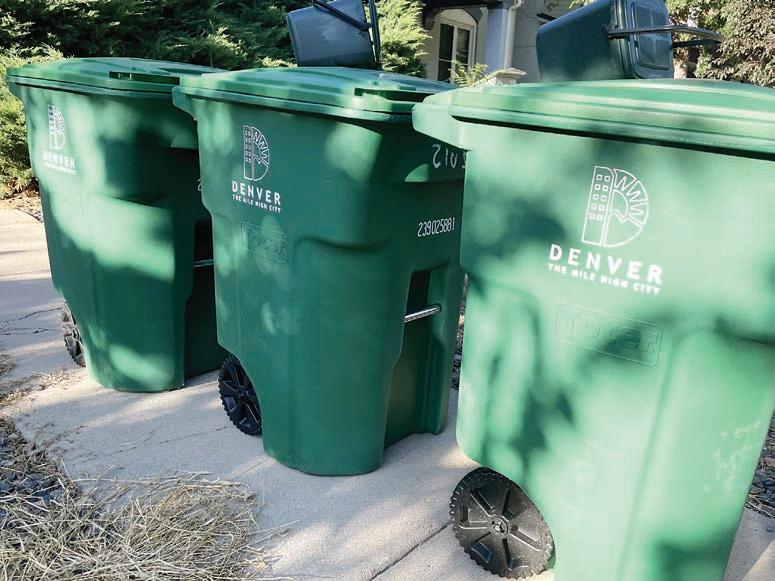
or large item pickup week online and can also download the smart phone app to see the schedule and get reminders at Denvergov.org/TrashSchedule.
At a Denver City Council Budget and Policy Committee meeting in November, DOTI presented an update on the program to the City Council. DOTI mentioned that the changes will allow the department to move their illegal dumping clean up team from eight hours a week to a full-time crew at 40 hours per week.
Councilman Kevin Flynn said it would be helpful if DOTI allows residents to have the option of the small compost bins because many residents in townhome communities don’t need the larger bins and often can’t t them in their garage.
DOTI indicated that is not an option as they have a low supply of the smaller bins, and they also have found that residents tend to overstu their bins, which is why the department is only o ering the larger compost bins.
Council President Amanda P. Sandoval, representative for North Denver, questioned why DOTI was dropping weekly recycling when the council members who sponsored the legislation to
e use of vacancy committees is far from a new phenomenon in Colorado politics.

move to volume-based trash pricing in 2022 had made it clear that the move to weekly recycling was very important.
“It feels ba ing to me that you all are coming back saying that you didn’t have it in the program to do weekly recycling,” Sandoval said to DOTI leadership in the committee meeting.
Sandoval also expressed disappointment with the change to recycling every other week and also noted that her family has full recycling bins every week.
Councilman Paul Kashmann also noted it was very clear to him that weekly

e candidates jostling for Hansen’s Senate seat are from a variety of backgrounds. As it stands currently, there are eight of them:
• Sean Camacho Hansen’s endorsed successor and Representative-elect for Capitol Hill.
• Iris Halpern, a civil rights attorney and former union organizer.
• Chris Chiari, owner of the Patterson Inn and a former lm director.
• Matthew Ball, policy director for Denver Mayor Mike Johnston.
• Monica VanBuskirk, former chief policy o cer for Colorado’s health exchange.
• June Churchill, a bicycle lobbyist known as “Denver’s bike mayor.”
• Shaneis Malou , chief of sta at the Auraria Higher Education Center.
• Jaime Lewis, an RTD board member and disability rights advocate.
According to recent studies, approximately one-third of sitting Colorado legislators have been selected for a position by a vacancy committee at least once in their careers. Some of the same Centennial state’s current legislators who were appointed through this process, are now engaging in ongoing debates about its democratic legitimacy.
ose who favor special elections over vacancy committees say that the vacancy committee system allows party insiders to make decisions that should belong to the constituents they serve, while proponents of vacancy committees argue it’s a practical solution that avoids costly and time-consuming special elections.
Colorado’s 2025 lawmaking term starts on Jan. 6, followed by the meeting at 6:30 p.m. Jan. 7 at Christ Church United Methodist, 690 Colorado Blvd., where we will see who replaces Hansen. e rst full regular session of the year for the general assembly is Jan. 8.



recycling was part of the volume based trash program during the process to pass the legislation. Councilman Chris Hinds, also expressed frustration that DOTI did not have a stakeholder process around changing to biweekly recycling.
In response to some of the comments, DOTI Director Amy Ford said research shows that while recycling is good from a reuse perspective, increasing compost is more bene cial from a greenhouse gas emissions perspective.













BY ERNEST GURULÉ SPECIAL TO COLORADO COMMUNITY MEDIA
With a new presidential administration soon to take the reins of the government, health experts are especially worried about the man set to become the country’s next Secretary of Health and Human Services and the movement he supports.
e concern is based on the long antivaccination history of nominee Robert F. Kennedy, Jr. Kennedy has falsely and repeatedly linked vaccines to autism, basing his claim on a discredited 1998 article published in the British medical journal, e Lancet.
e 1998 article linking the MMR (measles, mumps, rubella) vaccine to autism was almost immediately refuted but not before launching the rst major anti-vaccine movement. e article resulted in almost immediate collateral damage with an outbreak of more than 12,000 cases of measles and at least three deaths in Great Britain in the months following its publication.
e idea that a war on vaccines could once again erupt is causing great concern in the medical community, including in Denver.
“I think we’ve seen in the U.S. and the world when vaccine con dence falls, we
start to see disease again,” said Dr. Josh Williams, a Denver Health and Hospitals pediatrician.
In interviewing Dr. Williams, he made clear he was not responding to the Department of Health and Human Services nominee’s history of vaccine denial but answering only as an expert and proponent of vaccines.
In a world where a virus can hopscotch an entire ocean in hours, a virus can plant itself on a new continent in a single day and grow exponentially in a matter of weeks.
“ e diseases that our grandparents and parents saw,” Williams said, “are only a ight away. If our levels of immunity are not high enough, we will see these diseases.”
e polio vaccine was approved April 12, 1955. It was administered the following day at the Mayo Clinic. Today it is credited with all but wiping out polio in the western hemisphere.
While Dr. Jonas Salk’s polio vaccine remains one of the 20th century’s most renowned and reliable vaccines, there are others that have also performed in the same exemplary way.
Vaccines for 14 diseases, including diphtheria, hepatitis B, measles, meningitis A and yellow fever, according to the World
Health Organization, have reduced infant deaths by 40% globally and by 50% in Africa. ey are also credited with saving as many as 154 million lives worldwide over the last fty years, including more than 100 million infants.
In a seven-year period ending in 1955, polio changed our lives. Fairs and sporting events were cancelled, swimming pools and movie theaters were closed; the threat of polio was both frightening and omnipresent.
In 1952 there were more than 58,000 cases reported resulting in 3,200 deaths. Many survived the disease but were paralyzed for the remainder of their lives.
BY COLORADO COMMUNITY MEDIA STAFF
e Denver City Council recently passed a measure to allow accessory dwelling units (ADUs) in all residential zoning areas of the city.
e citywide ADUs measure was sponsored by Councilmembers Sarah Parady, Chris Hinds and Darrell Watson, in partnership with Mayor Mike Johnston and the Department of Community Planning and Development (CPD).
“In every corner of our city, the cost of housing is top of mind for Denverites, and simple improvements to our policies like this make a real di erence for working families,” Johnston stated. “As we continue to push to create thousands of units of a ordable housing, giving residents the option to build an ADU will not only make it easier for families to stay

• Aerial Yoga
• Iyengar Yoga
• Core, Strength, & Stretch
• Downshift & Restore w/ live music
in Denver long-term, but will put us one step closer to tackling the challenge of housing a ordability.”
Accessory dwelling units are self-contained, smaller living spaces with their own kitchen, bath and sleeping area that are an extension of an existing property, either attached or detached. ey are often called “mother-in-law suites,” “granny ats,” “casitas,” “backyard cottages,” “garage apartments” or “basement apartments.”
e measure allows ADUs on 70% of Denver’s land, compared to 36% before the new zoning rules were passed, which went into e ect Dec. 16.
e measure also implemented state legislation that requires Denver to allow accessory dwelling units in all residential districts, overriding rules by homeowner associations that prevent them and requires

e iron lung, a metal tube used for helping victims breathe because their lungs had become paralyzed, became the symbol of the disease. Other symbols were leg braces and wheelchairs, most often worn or occupied by polio’s surviving victims.
While a ban on the polio vaccine grabs most of the attention, Williams said, vaccines for ghting things as predictable as in uenza may also be put under the same cloud of suspicion in a new administration.
e CDC has recently documented a spike in whooping cough, including a single case in Colorado. A vaccine, including a booster every ten years, is recommended for diphtheria, tetanus and per-

tussis (DPT). Pertussis is informally called whooping cough.
Williams said the polio scare came home for him when his grandmother shared his own father’s polio vaccine cards with him. “ ey knew it (polio) was possible,” he said. “ eir home,” not unlike thousands in every state, “went under quarantine.”
President-elect Donald Trump has said that he will make certain that the polio vaccine remains available. But Kennedy’s words, most especially his belief that vaccines have “killed many, many, many, many, many more people than polio ever did,” provide less than full con dence to public health o cials.
updates to Denver’s owner occupancy requirement for single-unit zone districts.
Prior to passage of this measure, requirements dictated that if an owner didn’t live on the property, the ADU was not allowed to be used. e new rules allow an ADU to be used even if the owner later moved o the property.
“By streamlining the ADU process, we’re removing barriers that have made it challenging for homeowners to improve their properties and strengthen our communities,” Hinds said. “ is policy change would eliminate navigating Denver’s complex zoning code to build an ADU, and the city will save valuable time by eliminating the need for lengthy rezoning processes. is change not only simpli es the permitting process but also accelerates the timeline for residents to build what they need, ultimately making Denver a more
livable, accessible city for everyone.” e ADU measure also followed the city’s plan of updating building standards for ADUs to make them better t in di erent neighborhoods.
A report from the Joint Center for Housing Studies of Harvard University found that ADUs “have the potential to address a variety of housing-related challenges like a ordability, equity, and environmental issues. Moreover, because ADUs generally are small in ll units, they can achieve these gains without signi cantly altering the character of existing residential neighborhoods.”
ADUs can serve as a separate space where elderly parents or kids living at home can still have independence, a space that can be rented out to generate income, or just to rent a smaller, more affordable space.
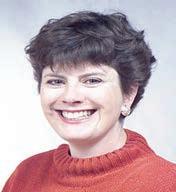
• Chanting, Wed. 8:05-9:05 am
• Meditation, Wed. 6-7:15 pm
• Sunday Study: slow & strong asana exploration
• Private and small group sessions
• Gong baths DONATION-BASED/FREE COMMUNITY CLASSES:

BY ERIC HEINZ
e area colloquially known as “South Broadway” has gone through many transformations over the years, yet it continues to be able to o er that speci c liveliness that Denver wouldn’t be the same without. at’s where the Broadway Merchants Association (BMA) and its supporters come in.
People on behalf of the BMA recently led an application with the city of Denver to create a 1.7-mile corridor that would be a business improvement district (BID), which would have businesses in the area pay into a fund that would establish more security presence, make improvements and help with promotions. Only properties within the BID would be subjected to the costs.
More than 260 businesses and 176 commercial properties would be included in the BID, if it is approved by the city. e district would impose a mill, the amount of which will be determined later, among the businesses based on their assessed value and in return the businesses would get more security, money for maintenance, marketing and advertising, as well as operational funding. e mill submitted to the city was at 21, or $21 for every $1,000 of the assessed property value.
e next step, coming in the next couple months, is to petition the businesses on whether they’d like to establish a BID, and then that would initiate the city council process on whether to approve the special district. e BID proposal would need majority support. e BMA and proponents for the BID submitted a preliminary operating budget of just over $2 million to the council, but Luke Johnson, president of the BMA, said that number is expected to drop as the association continues to determine its needs.
“ e plan is to take this up again right after the rst of the year and try to deal with some di erent issues and resolve it,” said William Feinberg, vice president of the BMA. “We’re trying to be as transparent as possible and have as much input from the people that it a ects as possible.”
From an open records request with the city, Colorado Community Media obtained the application and complementary information about the Broadway BID.
“It is common for any entity submitting a BID application to further revise their submitted documents before they are presented to city council for its consideration as a part of the creation ordinance process,” stated Josh Rosenblum, the communications specialist for the Denver Department of Finance. “ at is likely to be the case in this instance as well.”
Rosenblum said the petition, if all goes according to plan, is likely to be submitted in the spring. A city council committee meeting could then take place April 30 with a following public hearing on May 19. ese dates are very likely subject to change, depending on when the petition is submitted.
Why a BID?
e BMA is a Registered Neighborhood Organization that oversees the operations of the current district. But the leadership of the organization said they wanted something more robust.
“ is is something that’s been discussed and worked on over the years and it grew out of the BMA and it’s volunteer and has very limited capacity in terms of what it can really do, and a lot of the merchants who are members felt if we had something that was more structured and organized, and had more money, we could do more to promote the bars and di erent businesses and that was the motivation,” said William Feinberg, vice president of the BMA.
Public safety is one of the highest priorities for the Broadway Business Improvement Distict proposal, as it is slated to have the largest portion of the preliminary budget submitted by the BMA. Feinberg said there is a dearth of security in the corridor, except for businesses that pay for it on their own dime.
“Some property owners on individual properties have taken that step, but it’s not very e cient,” Feinberg said, adding that crime will just over ow to the next location if they don’t have congruent security.
“ e big thing really is that we want to create an environment,” Feinberg continued. “ We want an environment that is family-friendly and a place where they’ll come to participate in the unique and one-of-a-kind retail and food and entertainment establishments.”
Johnson echoed Feinberg’s sentiments by pointing to the expectations he has heard from his constituents.
“ e community is asking for aroundthe-clock security,” Johnson said. “ e community is asking for maintenance from 6th (Avenue) to I-25. e last thing we want is for this to be a burden on people, right? e whole goal is to make the street better and to make it more viable for, obviously, businesses but also the residents and the community.”

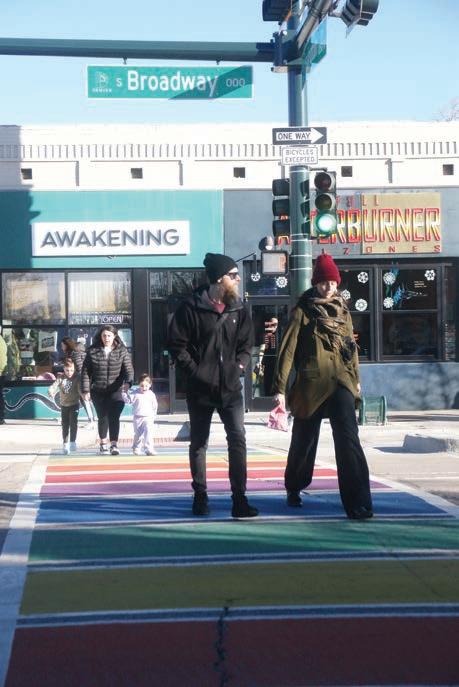

e nal cost to each of the businesses will be determined through the city council process.
“ e (Broadway Business Improvement District) represents a bold step toward revitalizing Broadway, creating a vibrant, safe, and prosperous district that serves both businesses and the surrounding community,” the BMA stated in its presentation materials. “ rough targeted initiatives in public safety, marketing, maintenance, and branding, the BBID is designed to foster economic stability, enhance the area’s visual appeal, and solidify Broadway’s identity as a des-
tination for locals and visitors alike. Supported by a well-planned budget and the active engagement of local stakeholders, the BBID aims to meet current challenges head-on, while laying the groundwork for sustained growth.”
Businesses that do not want to be included in the BID can ask the city to exclude them. Johnson said he’s hopeful that doesn’t happen, as it could create spots in the overall corridor to not be covered.
e BID would have its own board of directors, which is also to be determined at a later date.

A publication of
Mailing Address:
750 W. Hampden Ave., Suite 225
Englewood, CO 80110
Phone: 303-566-4100
To subscribe call 303-566-4100 or Scan this QR Code

BROOKE WARNER
Executive Director brooke@ntln.org
LINDA SHAPLEY
Director of Editorial & Audience lshapley@coloradocommunitymedia.com
ERIC HEINZ Editor eric@cotln.org
LINDSAY NICOLETTI
Operations/ Circulation Manager lnicoletti@coloradocommunitymedia.com
ERIN ADDENBROOKE
Marketing Consultant eaddenbrooke@coloradocommunitymedia.com
ERIN FRANKS Production Manager efranks@coloradocommunitymedia.com
BUSINESS INQUIRIES
For advertiser or vendor questions, please email our business department at accounting@ coloradocommunitymedia.com
Columnists & Guest Commentaries
Columnist opinions are not necessarily those of the Profile.
We welcome letters to the editor. Please include your full name, address and the best number to reach you by telephone. Email letters to eric@cotln.org
Deadline
5 p.m. on the 20th of each month for the following month’s paper.
Ah, the new year. at magical time when the calendar resets, the leftover holiday cookies mysteriously vanish, and we tell ourselves, “ is is the year I get my life together!” Fast-forward a few weeks, and we’re panic-Googling how to organize the junk drawer while eating snacks for dinner. Sound familiar?
Here’s the deal: resolutions tend to crash and burn because they’re too extreme. Instead of aiming for perfection, focus on goals—realistic ones that simplify your life, create balance and are actually doable for you and your family. Let’s dive into some practical, fun tips to kick o the new year with less stress and more joy.
For the adults: manageable goals that actually work
1. Embrace the power of “no”
Let’s start with this gem: you can’t do it all. Say “no” to that one extra meeting, bake sale, or event that will push you over the edge.
Goal: Say “no” to one obligation each week and enjoy the freedom. Practice in the mirror if necessary—“No, but thanks for asking!”
2. Make a “not-to-do” list
To-do lists are great, but what about the things that waste your time and energy? Doom-scrolling, reorganizing your fridge for the 15th time, or overthinking that a “Let’s get lunch!” text can all go on the not-to-do list.
Goal: Identify one time-sucking habit and
The Denver Public Library’s adult Winter of Reading program begins Jan. 2.
To help get you started on your reading journey, here are some snowy books to check out for yourself or to read to a young one.
WINTER OF READING

CORRECTIONS

On page 5 of the December edition of the Washington Park Profile in the story “Longtime Washington Park congregation moves, we are clarifying that the congregation is looking to sell its building, but not necessarily to an a ordable housing developer. In the same edition on page 2 in the story “DPS votes to finalize closure of seven schools,” the address of West Middle School was incorrect. The address is 951 Elati St.
Colorado Trust for Local News asks readers to make us aware of mistakes we may have made.

Email linda@cotln.org if you notice a possible error you would like us to take a look at.

“I’m Going to Build a Snowman” by Jashar Awan

LIFE BALANCED
cut it out (or down). Pro-tip: hand that o to TULA.
For the Kids: Fun Goals They’ll Actually Stick With
1. Learn one new skill

Quetzalli Cortez


A young boy wakes up ready to build the best snowman ever. Although he knows all the steps to making the perfect snowman, the snowman he builds seems to be a little o . Undiscouraged, the boy realizes what’s wrong just in time for his mom to take a picture of him and the best snowman ever.
“I’m Going to Build a Snowman” by Jashar Awan is an energetic and charming story. Awan perfectly captures the excitement and determination of a young child with a plan. e text is simple, with bold words and larger text emphasizing the energy of the young boy as he builds his snowman.
Awan’s illustrations are bright and bold, using simple shapes, all of which complement the text.
Children will get excited as the boy builds his snowman and giggle as he tries to gure out what’s wrong with the snowman. e overall message of the book will resonate with adults: joy can still be found in imperfection.
“I’m Going to Build a Snowman” is best for children ages 3 to 7.
“ e Girl Who Speaks Bear” by Sophie Anderson
Found near a bear cave as a baby, Yanka was adopted by Mamochka and raised in the vil-


Megan Trask and Cody Galloway

3. Schedule “me time” like a dentist appointment
If you can keep a dentist appointment, you can carve out 15 to 30 minutes just for yourself. Whether it’s reading, meditating, or zoning out with a cup of tea, make it non-negotiable.
Goal: Schedule weekly “me time” on your calendar. Protect it ercely.
4. Tackle one chaos zone
Every house has that one thing. e junk drawer, the Tupperware cabinet, or the laundry chair (we see you). Choose one area to declutter and breathe a sigh of relief every time you look at it.
Goal: Start small. One drawer or one shelf— baby steps!
5. make exercise fun (no gym required)
Skip the boring treadmill. Dance in your kitchen, join a local pickleball league, or take a walk while listening to your favorite podcast. Moving your body doesn’t have to feel like a chore.
Goal: Find one fun way to move three times a week for 20 minutes.

lage. Although Mamochka and her friends are loving, Yanka often feels alone. On the day of the village’s winter festival, Yanka nds she is suddenly able to talk to animals and has grown bear legs. Sensing that she will nd answers in the forest, Yanka heads out on her own, ignoring the advice of her Mamochka and friends.
Heavily inspired by Russian fairy tales, “ e Girl Who Speaks Bear” by Sophie Anderson is a whimsical, action-packed adventure. Anderson does a fantastic job with her world building, naturally incorporating and explaining the Russian fairy tales she is taking inspiration from. Bear Tsars, Baba Yagas and dragons all make an appearance in this fantastical tale about found families and identity.
“ e Girl Who Speaks Bear” is a great book for parents to read at bedtime to younger children who are interested in fairy tales and adventures. Adolescent readers will sympathize with Yanka’s fears of being an outsider and her desire to belong.
Kids thrive on challenges. Whether it’s tying shoes faster, learning a new recipe, or mastering their favorite trick shot, give them a fun goal they can work toward. Kid Goal: “I’m going to learn how to [ ll in the blank] this year!” Keep it simple and praise progress.
2. Start a “Kindness Jar”
Encourage kids to jot down one kind thing they do each week and add it to a jar. At the end of the year, they’ll see all the good they’ve done (and you’ll enjoy a few sibling cease res along the way).
Kid Goal: Do one small kind act weekly, like sharing a toy or helping around the house.
3. Get Outside Daily
Fresh air is the ultimate boredom buster. Bundle up for a nature walk, build snow forts, or just let the kids run wild in the backyard.
Kid Goal: Spend 20 minutes outside every day (even if it’s just to yell, “it’s freezing!” and come back in).
4. Organize one thing they love
Whether it’s their toys, art supplies, or beloved Lego stash, let kids take charge of organizing something they care about. Kid Goal: Keep one area tidy. Even if it’s tiny, it’s progress!
5. Make a “no-screen fun list”

“ e Girl Who Speaks Bear” is best for children ages 9 to 12.
To sign up for Winter of Reading, stop by your local library branch and ask the front desk to participate. Learn more about the Winter of Reading programs at Decker branch at denlib. org/decker.
Quetzalli Cortez is a librarian at the Decker Branch Library. She loves reading, cooking and exploring parks with her dog.
Urology and gynecology often work together, this is how the eld of urogynecology evolved.
e doctor’s focus is on the urinary tract and the female reproductive systems in tandem.
ere is potential overlap in these systems and conditions with the female urinary system and reproductive organs being closely situated in the body.
e Mayo Clinic cites that urinary incontinence and involuntary leakage are common symptoms that a ect 50% of adult women. Around 50-60% of women will experience a urinary tract infection (UTI) in their lifetime. ese percentages show the importance of having specialized urogynecologists dedicated to restoring the normal function and autonomy to help women regain their con dence.
A urogynecologist can diagnose and treat many disorders in women such as pelvic oor dysfunction. e pelvic oor has muscles, ligaments and con-
WOMEN’S WELLNESS

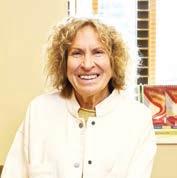

Dr. Terry Dunn


nective tissues all supporting organs in the pelvis. ese organs are the bladder, vagina, uterus and rectum that are responsible for basic bodily functions like urination and bowel movements. e organs located in the pelvis are key indicators of a healthy female reproductive system.
Urology diagnoses and treats conditions relating to the urinary tract that can include pelvic oor disorders, urinary tract infections (UTIs), infertility, incontinence and pelvic oor prolapse. A urologist is specialized to deal with complex urinary tract problems in both women and men such as an overactive bladder or blood in the urine (hematuria).
Gynecology focuses on the repro-
ductive organs with services for specialized care for women’s reproductive needs. Beyond pregnancy this can include menopause, hormonal problems, menstruation and contraceptives. Specializing in women’s reproductive health, gynecologists conduct pap smears, pelvic exams and cancer screening procedures. Some gynecologists are also obstetricians (OBGYNs) that additionally specialize in pregnancy and childbirth.
Urogynecology o ers a full spectrum of women’s health care assessments from breast and pelvic exam preventive care to urinary incontinence and pelvic oor disorders. It brings everything urology and gynecology have to the table to e ectively diagnose and treat a variety of conditions.
Dr. Terry Dunn is the owner of Foothills Urogynecology, a Denver-based practice specializing in women’s health. To learn more, visit www.urogyns.com.




Screens are great, but too much can lead to meltdowns (for everyone). Help kids brainstorm screen-free activities, like building with Legos, playing board games, or crafting something cool.
Kid Goal: Do one “no-screen” activity every day.
Balance, not perfection e key to starting the new year right isn’t about perfection. It’s about setting realistic goals that reduce stress and create balance for the whole family. e beauty of goals (unlike resolutions) is that they’re exible and achievable.
So, skip the “New Year, New Me” pressure. Tackle one small thing at a time, make space for what matters, and remember to have a little fun along the way. And if all else fails? ere’s always co ee, humor, and a whole year to get it (mostly) right.
You’ve got this!
Megan Trask and Cody Galloway are Denver residents and co-founders ofTULA Life Balanced. Learn more about their business at tulabalanced.com.


BY MERYL PHAIR SPECIAL TO COLORADO COMMUNITY MEDIA
Devin Jamroz knows there is something special about the white wheat variety known as India Jammu that is grown in Colorado.
e CEO of the company Dry Storage in Boulder said the grain made its way to the front range after being pulled from a seed vault in 2020 and passed into the hands of local baker Andy Clark at Moxie Bread Co. in Louisville.
Clark milled some but got so excited over the bread it produced that he handed it o to the MASA Seed Foundation in Boulder where it wound up with several local farmers and eventually to Dry Storage as they were putting together their inventory of local grains.
“We launched it (Indian Jammu) a month ago and we’re getting it into more chefs and baker’s hands to play with,” Jamoz said. “It could potentially change the game and change the narrative around the usability of single-varietal, stone-milled ours because it is just so easy to use.”
While Colorado is known to grow high-protein winter wheat due to the temperature uctuation and a relatively short growing season, Jamroz said more than 80% of the wheat grown in the state is shipped elsewhere.
Local grains can be expensive compared to commodity our and more
challenging to work with due to their unique characteristics, but the appeal of local sourcing along with heightened nutrition and taste has been bringing regional our back to Denver’s food scene.
Launched with a mission of bringing local grains back into the supply chain, James Beard Award-nominated chef Kelly Whitaker and Id Est Hospitality founded Dry Storage in 2019 to create a product they were struggling to nd in the local market.
Following a successful trial with six local farms in the San Luis Valley, Dry Storage has partnered with local farms using regenerative and organic practices, milling their wheat and distributing the four to a growing number of regional partners, along with operating a cafe, grain mill and bakery based in Boulder.
Similarly to many mass-produced staples such as co ee, modern mills can produce large quantities of commodity our with a consistent avor pro le, enabling identical products to be created anywhere. Stone mills like the one used by Dry Storage don’t strip away as many nutrients, maintaining the grain’s unique avor pro le. “ ere’s an undeniable taste of Colorado,” Jamroz said. “You can tell the di erence between wheat that’s been grown here and grown elsewhere.”
LOCAL GRAINS, P9










